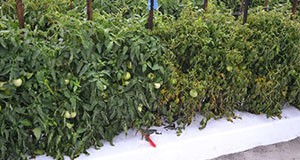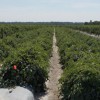 Bs2 tomatoes are transgenic tomatoes that have been engineered to contain the Bs2 gene from pepper. As such, they are considered a genetically modified (GM) food, or a genetically modified organism (GMO). Numerous trials conducted by University of Florida researchers have shown the benefits of these cultivars for bacterial spot disease management, and growers and industry members recognize the potential for Bs2 tomatoes to make Florida tomato production more sustainable. This 4-page fact sheet discusses the benefits that might be realized by the adoption of Bs2 tomato varieties, and the challenges standing in the way of their commercial production. Written by S. F. Hutton, J. W. Scott, J. B. Jones, R. E. Stall, G. E. Vallad, B. J. Staskawicz, and D. M. Horvath , and published by the UF Department of Horticultural Sciences, April 2015.
Bs2 tomatoes are transgenic tomatoes that have been engineered to contain the Bs2 gene from pepper. As such, they are considered a genetically modified (GM) food, or a genetically modified organism (GMO). Numerous trials conducted by University of Florida researchers have shown the benefits of these cultivars for bacterial spot disease management, and growers and industry members recognize the potential for Bs2 tomatoes to make Florida tomato production more sustainable. This 4-page fact sheet discusses the benefits that might be realized by the adoption of Bs2 tomato varieties, and the challenges standing in the way of their commercial production. Written by S. F. Hutton, J. W. Scott, J. B. Jones, R. E. Stall, G. E. Vallad, B. J. Staskawicz, and D. M. Horvath , and published by the UF Department of Horticultural Sciences, April 2015.
http://edis.ifas.ufl.edu/hs1259
Tag: John W. Scott
Compact Growth Habit Tomatoes
 Alternatives to the traditional production system that reduce production cost would be economically beneficial to the Florida tomato industry. Compact growth habit tomatoes are determinate varieties with a unique architecture that may provide the basis for a viable alternative production system for Florida. These tomatoes have low growth and spreading characteristics, forming compact plants that hold fruit above the ground on short branches. They do not require staking, tying, or pruning, so they may be used by the Florida mature-green fresh-market tomato growers to reduce labor costs. This 5-page fact sheet was written by Monica Ozores-Hampton, Aline Coelho Frasca, John Scott, and Samuel Hutton, and published by the UF Department of Horticultural Sciences, September 2014.
Alternatives to the traditional production system that reduce production cost would be economically beneficial to the Florida tomato industry. Compact growth habit tomatoes are determinate varieties with a unique architecture that may provide the basis for a viable alternative production system for Florida. These tomatoes have low growth and spreading characteristics, forming compact plants that hold fruit above the ground on short branches. They do not require staking, tying, or pruning, so they may be used by the Florida mature-green fresh-market tomato growers to reduce labor costs. This 5-page fact sheet was written by Monica Ozores-Hampton, Aline Coelho Frasca, John Scott, and Samuel Hutton, and published by the UF Department of Horticultural Sciences, September 2014.
http://edis.ifas.ufl.edu/hs1231
Postharvest Quality and Decay Incidence among Tomato Fruit as Affected by Weather and Cultural Practices. (PP294)
 Postharvest decay losses for field-grown, fresh-market tomatoes are usually associated with harvests that occur when fields are wet and warm. During periods of persistently wet fields, decay pathogens infect damaged fruit on the plant as well as injuries to petioles and stems. Review of all reports and photos implicated excessive water in fruit rather than air temperatures as the primary predisposition. Excessive water in fruit is possible at virtually any time of the season and can appear at times of cold as well as warm field temperatures. This 8-page fact sheet was written by Jerry A. Bartz, Steven A. Sargent, and John W. Scott, and published by the UF Department of Plant Pathology, July 2012.
Postharvest decay losses for field-grown, fresh-market tomatoes are usually associated with harvests that occur when fields are wet and warm. During periods of persistently wet fields, decay pathogens infect damaged fruit on the plant as well as injuries to petioles and stems. Review of all reports and photos implicated excessive water in fruit rather than air temperatures as the primary predisposition. Excessive water in fruit is possible at virtually any time of the season and can appear at times of cold as well as warm field temperatures. This 8-page fact sheet was written by Jerry A. Bartz, Steven A. Sargent, and John W. Scott, and published by the UF Department of Plant Pathology, July 2012.
http://edis.ifas.ufl.edu/pp294
PP259 Tomato Purple Leaf Disorder: A New Challenge for the Tomato Industry in Florida
PP259, a 2-page illustrated fact sheet by Gary E. Vallad, Bielinski M. Santos, Jane E. Polston, David J. Schuster, Andrew W. MacRae, Jeremy D. Edwards, and John W. Scott, describes this disorder, TPLD, observed in tomato fields in Hillsborough, Manatee, and Miami-Dade counties since 2006 — symptoms and field distribution, and the state of current research into the disorder. Published by the UF Department of Plant Pathology, November 2008.
http://edis.ifas.ufl.edu/PP259